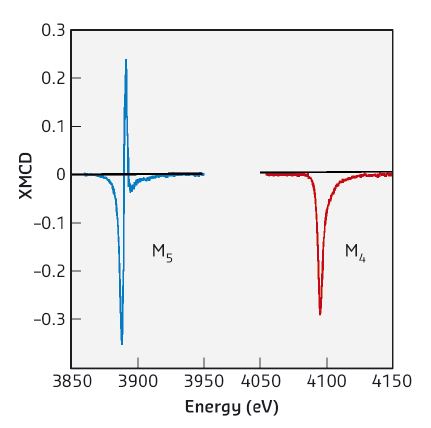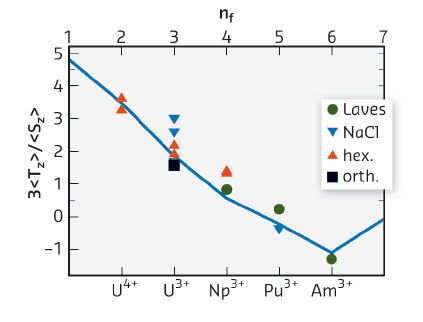- Home
- Users & Science
- Scientific Documentation
- ESRF Highlights
- ESRF Highlights 2015
- Electronic structure, magnetism and dynamics
- Exploring actinide magnetism with XMCD
Exploring actinide magnetism with XMCD
Experiments performed on AmFe2 have demonstrated that the magnetic dipole term of actinide materials can be determined by X-ray magnetic circular dichroism (XMCD) together with the spin and orbital magnetic moments. Accessing this information with a single experiment will help researchers solve the long-standing problem of modelling the complex electronic structure of the actinides.
Actinides are the heaviest elements in the periodic table that can be studied on a macroscopic scale. The complexity of their electronic structure often produces exotic physical properties such as the unconventional superconductivity of PuCoGa5 and the “hidden order” phases found in NpO2 and URu2Si2.
The magnetic moment carried by an atom is given by the sum of two components, one associated with the spin of the atom, the other with its angular momentum, μ = μS + μL. The determination of these quantities in actinide compounds has been of interest since several decades ago, but it is still a formidable experimental and theoretical challenge. XMCD is a well-established tool to determine these quantities by using two “sum rules” that correlate the measured dichroic signal at two distinct spectral edges with μS and μL. Contrary to neutron techniques, XMCD does not require single-crystal samples, is element- and shell-specific, and microgram samples are sufficient. This is important for actinides, as single crystals are seldom available, and large quantities are difficult to manipulate. Unfortunately, the situation is complicated by the spin-dependent asphericity of the electronic cloud. While μL can be directly measured by XMCD, the accessible “effective” spin value is not equal to μS, but is the sum of μS and a quantity proportional to the expectation value of the magnetic dipole operator <Tz>. The latter is an elusive quantity that is experimentally accessible only in a limited number of cases, and not with any single experiment.
 |
|
Fig. 60: XMCD spectroscopic shapes for the Am M5 and M4 edges in AmFe2. The sum of the areas under the two curves is proportional to the orbital component of the magnetic moment. A weighted difference of the two areas provides the sum of the spin component with the expectation value of an operator related to the spin-dependent asphericity of the electronic cloud. |
Our experiment was performed at beamline ID12 by recording across the M4,5 absorption edges of Am (Figure 60). It took advantage of the fact that trivalent americium ions have an f6 configuration with L = 3 = –S and J = L + S = 0. Thus, Am3+ ions have no intrinsic magnetic moment, but their electrons can be strongly spin-polarised. A purely induced magnetic moment can be created in Am3+ by applying a magnetic field; this induced magnetic moment μ has the peculiar property that μS is always opposite and twice as large as μL. To maximise the effect, we took advantage of the strong exchange coupling in AmFe2; the ferromagnetically ordered iron sublattice generates a much larger field at the Am3+ ions than can be applied externally. Measuring μL by the first XMCD sum rule led by the reasoning above to a value of μS, and, by comparing its value to the effective spin moment obtained by the second sum rule, the contribution of <Tz> was quantified. Furthermore, the obtained value of <Tz> is in agreement with calculations performed by a single-ion model, which is consistent with earlier results on lighter actinides (independent of their crystal structure or the details of their electronic configuration). Therefore, by applying this correction it is possible to obtain a reliable value of μS for any actinide-based compound from a single XMCD experiment.
 |
|
Fig. 61: Ratio between the expectation values of the magnetic dipole operator 3<Tz> and the spin operator <SZ> as a function of the 5f shell occupation number nf. Experimental data for different compounds are represented by symbols identifying their crystal structure. Calculated values are shown by the solid line. |
By comparing the value of 3 <Tz> / <Sz> for nf = 6 to that of other 5f compounds (Figure 61) with nf ≤ 5, we infer that this quantity is well described within a single-ion, intermediate coupling theory for all light actinides, in a way that is independent of their electronic (de)localisation. This finding resolves a longstanding issue of what to use for <Tz> in interpreting XMCD experiments at the actinide M4;5 (or N4;5) edges.
Principal publication and authors
Magnetic polarization of the americium J = 0 ground state in AmFe2, N. Magnani (a), R. Caciuffo (a), F. Wilhelm (b), E. Colineau (a), R. Eloirdi (a), J.-C. Griveau (a), J. Rusz (c), P. M. Oppeneer (c), A. Rogalev (b) and G.H. Lander (a), Physical Review Letters 114, 097203 (2015); doi: 10.1103/PhysRevLett.114.097203.
(a) European Commission, Joint Research Centre (JRC), Institute for Transuranium Elements (ITU), Karlsruhe (Germany)
(b) ESRF
(c) Department of Physics and Astronomy, Uppsala University (Sweden)



